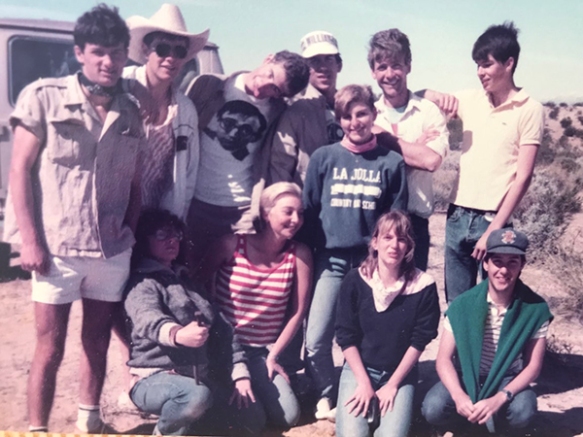by Rachel Norton, Executive Director
One of the best parts of my job is spending time in parks, and I’ve had a great time in the last six months visiting at least a half-dozen state parks for the first time. However, one of the most meaningful and fun visits I’ve taken was to a place I’d actually visited as a teen 35 years ago.

With my friends and classmates in the Mojave Desert in 1984
Mitchell Caverns, the only limestone caverns in the state park system, reopened to the public on November 3. Named after Jack and Ida Mitchell, a couple who operated a resort at the site from 1934- 1954, the caves offer spectacular limestone formations like stalagmites, stalactites, helictites, lily pads, draperies, curtains and cave coral. Recently, the Department of Parks and Recreation hosted a private reopening ceremony for park supporters and members of the Mitchell Family, and I was fortunate enough to be able to attend. Representatives of the indigenous Chemehuevi people were also on hand to bless the Caverns, a place they regard as the sacred eyes of the mountains (you can see why as you approach the Caverns from the trail).

The openings to Mitchell Caverns at Providence Mountains State Recreation Area, October 2017
Providence Mountains State Recreation area, the home of Mitchell Caverns, is in the eastern Mojave Desert, one of the more remote places in the state park system (let alone the country). The easiest way to get there from my home in San Francisco is to fly to Las Vegas and then drive three hours southwest to the park. There are campgrounds in the park, but the closest indoor place to stay is in Needles, an hour away. Once you leave Interstate 40, it’s not uncommon to have the entire two-lane road to yourself for long stretches.
When I was in high school, I was fortunate enough to have a biology teacher who had studied herpetology (reptiles) and was passionate about desert wildlife and ecology. Each year she took a group of students to the Mojave for a week on spring break, and I was lucky enough to go three years in a row (I loved the trips so much she let me tag along even when I was no longer her student). It was an incredible learning experience that introduced me to the beauty and vibrancy of a place that is often misunderstood as being devoid of both qualities. And as I walked into Mitchell Caverns on my visit several weeks ago, I realized I’d been there before!
Sure enough, when I looked back at my high school photo album (from the days when we used actual film and waited days to get our vacation photos developed and printed!) there was an identical shot of the Caverns from one I’d taken days before. Though interactions with the carbon dioxide from our breath and oils from our fingertips degrade the caverns over time, they are in remarkably good shape – I’m proud that the California State Parks Foundation was able to provide $10,000 from our grants program to help restore the caverns and reopen this remarkable place to the public.
If you visit, you must have a reservation – you cannot enter the caverns without a guide. Essential information about planning your visit is available on the state parks web site.




